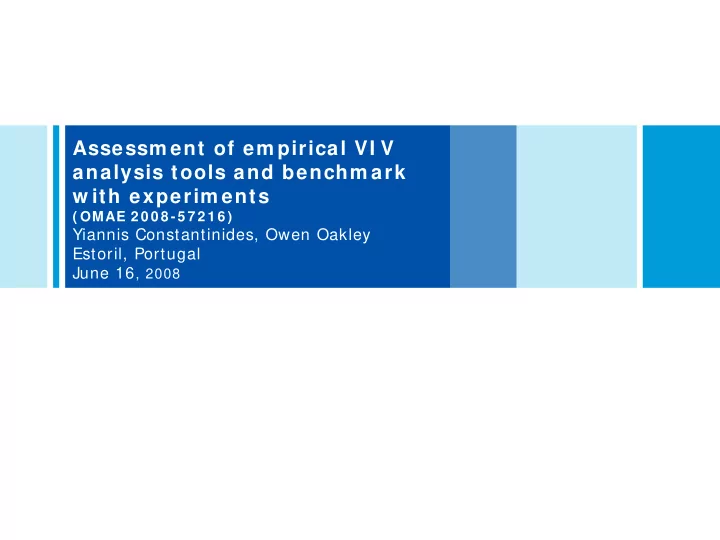

Assessm ent of em pirical VI V analysis tools and benchm ark w ith experim ents ( OMAE 2 0 0 8 - 5 7 2 1 6 ) Yiannis Constantinides, Owen Oakley Estoril, Portugal June 16 , 2008
I ntroduction and Background � Most VIV designs are based on empirical VIV tools � Empirical tools combine a frequency domain structural solution with an empirical hydrodynamic model � Linear frequency domain structural model (FE, FD, modal superposition) � Forced 1DOF CF hydrodynamic database (no inline) � Various assumptions on strip theory and VIV � Examples: Shear 7, VIVA, VIVANA, others (15+ years in development) � Popular among designers due to ability to analyze a big number of cases fast � Accuracy and validity often questioned especially with latest experimental findings � Careful benchmark and understanding of modeling limitations is very important � Ensure safe design � Drive improvements 2
Objectives � Develop a benchmark methodology meaningful to design � Demonstrate application on 2 selected software � Ongoing work over years to aid design � Compare only 1 st crossflow harmonic not total fatigue Factor of 3 0 off 1 Shear7V4.5 0.9 Total Cross-flow 1x Component 0.8 0.7 Expr. XbyL (top end = 1) Data 0.6 0.5 0.4 Current 0.3 VIV models 0.2 0.1 0 -1 0 1 2 3 4 10 10 10 10 10 10 Fatigue Damage (1/Yr) 3
W hat to com pare – design driven approach � Production risers consist of ~ 40ft joints welded together � Weld locations are critical for design � Location and components at the ends are also critical � Ability to predict local stresses in these areas � Compare local measurements with prediction along riser � Strain measurements are preferred � Acceleration or a combination of motion with frequency is a second alternative 4
Definitions � Spatial comparison based on point measurement � Define bias � Mean and std of bias (spatial) p (prediction) e (experimental sensor data) 5
Benchm ark case selection Experiments and Scaling � Nonlinear physics require extensive Deepwater benchmark in a range of operating conditions Flexible cylinder exp. (Low mode) � Empirical tools require even further Hydrodynamic scaling Rigid cylinder exp. Risers testing due to the different assumptions used � For production risers ensure success in modeling: Flexible cylinder � Geometry (0,50,75,100 Strake coverage) exp. (high mode) � Riser Response (low/ high mode… ) Structural scaling � Current profiles � Hydrodynamics (High Re) � High Harmonics � Validation against available field measurements � Validation � NDP experiments L/ D~ 1407, L= 38m (Geometry, Low/ Med mode, simplified currents) (presented here) � Field full scale, DeepStar high L/ D, full scale CFD cases (not published) 6
Benchm ark against NDP experim ents � NDP experiments Uniform flow Experiment designed to understand VIV and validate tools L/ D ~ 1407, L= 38m Strain gauges, accelerometers Linear shear flow Benchm ark Cases 7
Procedure � Analyze experimental data and create benchmark database � Select “steady-state” � Separate harmonic content � Calculate fatigue damage (index) � Select 2 empirical tools and use them as used in design � Model experiment with empirical tool and run cases � Compare results and generate statistics 8
9 Linear shear flow Uniform flow Results for selected cases - strain Soft. A Soft. B
10 Linear shear flow Uniform flow Results for selected cases - strain Soft. A Soft. B
Sum m ary plots 5 0 % strake - fatigue Soft A – Shear 5 0 % strakes Soft A – Uniform 5 0 % strakes Overestim ate 1 0 1 0 . 1 Underestim ate Soft B – Shear 5 0 % strakes Soft B – Uniform 5 0 % strakes 11
Fatigue bias sum m ary – Softw are A � Statistics of bias 3 2 for all cases 1 μ 0 � Represent -1 spatial variation -2 0 20 40 60 80 100 120 140 160 and deviation 1.5 � Log of bias μ 1 and σ σ 0.5 0 0 20 40 60 80 100 120 140 160 0 -5 log(D n ) -10 -15 0 20 40 60 80 100 120 140 160 Note: High harmonics contribution not included 12
Fatigue bias sum m ary – Softw are B 6 � Statistics of bias 4 for all cases 2 μ � Represent 0 spatial variation -2 0 20 40 60 80 100 120 140 and deviation 3 � Log of bias μ 2 and σ σ 1 0 0 20 40 60 80 100 120 140 0 -5 log(D n ) -10 -15 0 20 40 60 80 100 120 140 Note: High harmonics contribution not included 13
Conclusions � Benchmark methodology has been proposed and applied to empirical VIV models focusing on 1 st CF harmonic � Benchmark shows wide deviation from experiments � Scatter varies across geometries and velocities � Challenges in modeling strakes � Overall one tool is better than the other � No inclusion of fatigue due to high harmonics � Not fit for generic geometries � Given difficulties in matching laboratory scale VIV, effectiveness at full scale and other experiments is in question � Calibration and enhancements are critical � Education of developers, designers and analysts on limitations and state of the art 14
15 Thank you !
Recommend
More recommend